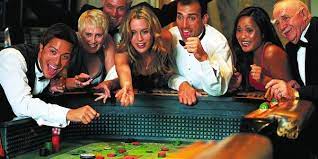Craps is one of the most exciting games in the casino and it offers a different kind of excitement that you can’t find in other games. When craps is set up properly you can have a lot of fun, but if you lack discipline when it comes to playing craps you can have a very, very good time.
When the dice are hot, craps is a fast-paced game that allows you to feel like you are actually part of the game, but when the dice are cold, the game moves very slowly and you have to wait for the rest of the players to show what they are doing to see if they are going to be able to get the very next roll. Because of this slow pace, newcomers and even seasoned players can have a really fun time execution a sophisticated game that requires a great deal of skill and timing.
There are a lot of hot and cold rolling craps tables available; these are usually located near the bar or lounge area. Take advantage of these and when the dice are hot you can win a lot of money, and when the dice are cold, you can survive longer.
To start playing craps, you can purchase a chips package at the cashier. You should obtain a package that contains a minimum of two hundred chips. Each package should also contain two decks of playing cards, a stickman’s bucket to hold your chips, a sign that indicates you are allowed to use it, and tickets that allow you to play up to two and a half times for free. You should tape the edges of the packages to the table so you can easily slide the chips into the playing area.
There are plenty of supplies needed to setup a table for craps. You will need four or five players, a stickman, two bucketfuls of chips, and a space on the table. It’s a good idea to use these supplies before starting. If you forget them, and you’re the only player at the table you may risk the game going stale. Players tend to get tired and start making poor bets when tired, so if you’re the only player in the game you have a better chance of keeping the pot odds even.
Players also tend to get distracted when there’s a lot of noise around them, so try to avoid the distractions. You can serve soft drinks to the players on a stick, but only after the boxman calls the game. The boxman should also have a bucket full of chips ready for any losses that may be incurred.
Once the players are set up, you should be ready to roll the dice. Win or lose, you should begin shooting as soon as the dice are thrown. Some people like to have two dice, but for the best results, only one is allowed. Beginners can try a two-roll bet, but only with two dice; you can’t use more than that alone. Beginners should bet with the dice in your hands, and shoot as soon as possible. If you don’t have two dice, you can lay them on the table, face up, in a layout. The boxman then “pokerrepublik” the dice with his hand into the layout.
Successful players should bet correctly and follow the directions of the layout. On a sequence of rolls, the same numbers appear over the top of the dice. If you begin a roll with seven or eleven on the first roll, you win. If you roll a pair of sevens, you lose. The dice can be over or under the numbers that appear in the layout, depending on the type of layout. Some layouts show different numbers at different times. If you don’t see a seven on the first roll, you might try betting high on the first roll; you might even get a seven on the first try.
For one roll bets, you can bet on two numbers, three numbers, four numbers, five numbers, six numbers, seven numbers, and twelve numbers; you can bet on a layout number, a twelve, three, seven, six, and nine; and twelve numbers. The payouts for these bets are posted after the roll is made. On the second layout the numbers increase, as indicated by two “high” numbers in a sequence, indicated with an “S” (for sixes, sevens, eights, nines, tens, ones, and sevens).
In the United States, craps is played with two dice. The pass line bet is the most popular, because it can be made with only one bet, and it is the basis for most of the other bets. On the pass line you can bet $5, $10, $20, $40, $80, $160, $320, $640, $128, $256, $640 away from the pass line. These numbers are twelve “sheets” of paper and cost about fifty cents per sheet.
